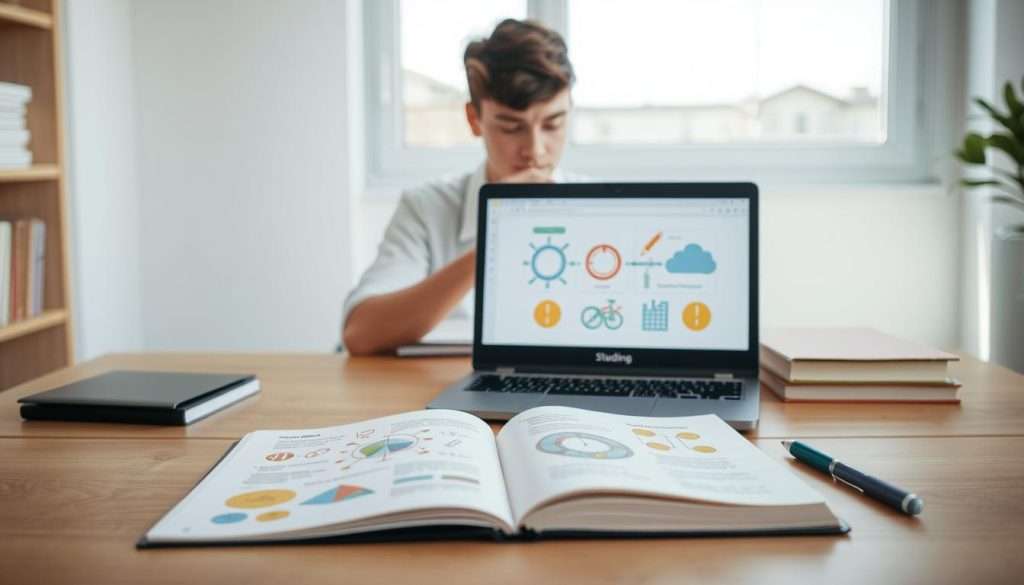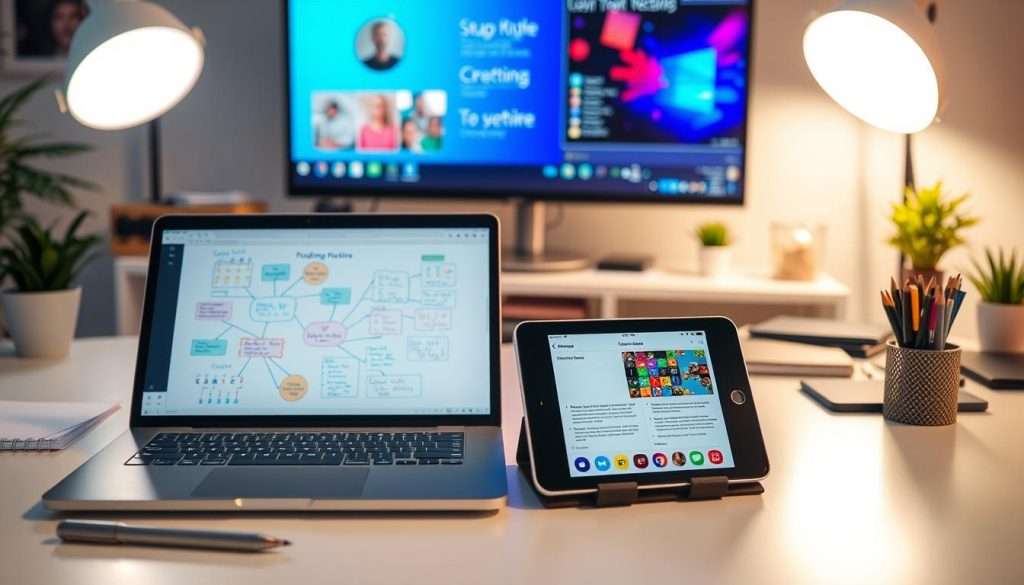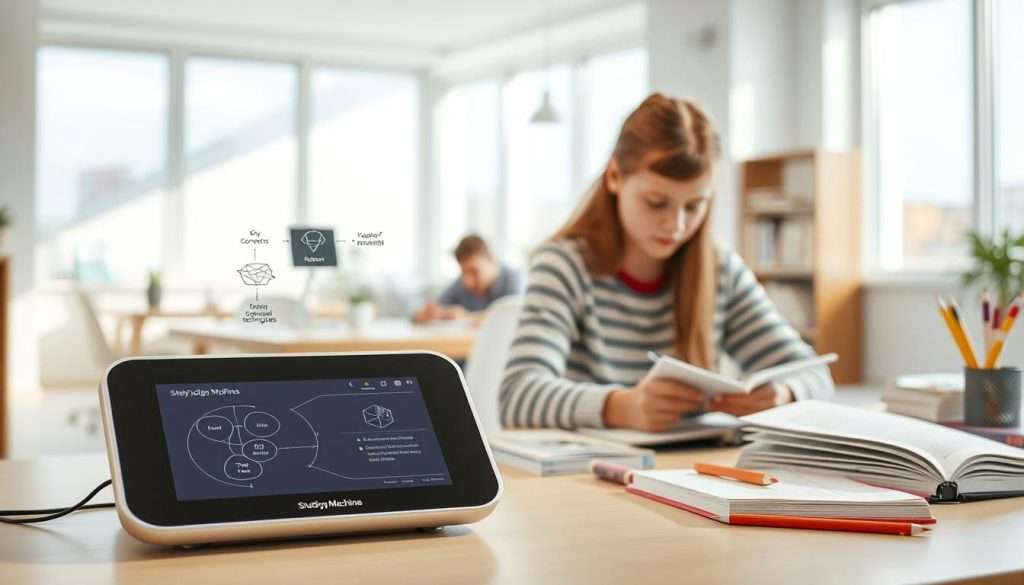Imagine being able to learn and remember more by mixing what you see and read. The dual coding study method makes this possible. It uses both pictures and words to help you learn better.
When you add images, diagrams, or videos to your reading, you remember more. Megan Smith & Yana Weinstein say, “Dual coding is combining words with pictures.” This way, you can remember information better because you’ve learned it in two ways.
Let’s dive deeper into how dual coding can make you a better learner.
Key Takeaways
- Combining visual and verbal information enhances memory retention.
- The dual coding study method improves comprehension by encoding information in multiple ways.
- This cognitive learning strategy can be applied to various subjects and learning materials.
- Using images, diagrams, or videos alongside text can boost learning outcomes.
- Dual coding is a simple yet effective education strategy to enhance your learning potential.
Understanding the Dual Coding Study Method
The Dual Coding Study Method works by using both visual and verbal processing in the brain. It’s based on the Dual Coding Theory. This theory says our brains handle visual and verbal info in different ways.
The Science Behind Dual Coding Theory
Allan Paivio’s research shows that using visuals and words together boosts learning and memory. By tapping into both channels, we can improve our ability to process and retain information. This is because our brain can store info in more than one way, making it easier to remember.
Visual and Verbal Processing Systems
Our brains have two main systems: one for seeing things and one for hearing words. The visual system deals with pictures and diagrams. The verbal system handles text and spoken words. Using both systems together makes learning more effective and memorable. Paivio’s work shows that using both visual and verbal info helps us understand complex ideas better.
The History and Development of Dual Coding Theory
Let’s explore the story of Dual Coding Theory and its impact on education. It started with psychologist Allan Paivio. He found that our brains process information in two ways: through pictures and words.
Allan Paivio’s Original Research
Allan Paivio’s research was key to Dual Coding Theory. He showed that mixing pictures and words helps us remember better. His ideas changed how we learn, showing that images and text together work best.
This theory has shaped how we teach today.
| Key Findings | Description |
|---|---|
| Dual Processing | Information is processed through both visual and verbal channels. |
| Enhanced Recall | Using both visual and verbal information together improves memory recall. |
Modern Applications in Education
Now, Dual Coding Theory is used in schools. Teachers use pictures, diagrams, and infographics to help students understand. This method boosts student interest and understanding, especially for hard topics.
By using both pictures and words, teachers reach more students. This makes learning more fun and effective.
Why Dual Coding Works: The Cognitive Science Perspective
Let’s explore the world of cognitive science to see why dual coding is so powerful. It’s not just a study trick; it’s based on how our brains handle information. By mixing visuals and words, dual coding uses both our visual and verbal skills.
Working Memory and Cognitive Load
Our working memory is like a mental sticky note for temporary info. Dual coding spreads info across visuals and words. This lowers cognitive load, making it simpler for our brains to grasp and keep info.
“Dual coding reduces cognitive load by spreading info across two channels,” as “Unlock Your Potential” points out. With less cognitive load, we can focus and learn better.
Here’s a simple example of how dual coding can help:
| Study Method | Cognitive Load | Retention Rate |
|---|---|---|
| Text-only | High | Low |
| Dual Coding | Low | High |
Strengthening Neural Connections
Dual coding doesn’t just cut cognitive load; it also builds neural connections in our brains. By linking visuals and words, we create more paths for info retrieval. This makes remembering info quicker and easier.
“The more we practice dual coding, the more our brains become wired to learn and retain information effectively.”
Benefits of Using the Dual Coding Study Method
The Dual Coding Study Method has many benefits for learning. It uses both visual and verbal systems to help you remember better. This way, you can grasp complex ideas and recall them easily.
Enhanced Memory Retention
Dual coding makes remembering information easier. It creates more ways to recall what you’ve learned. This is thanks to research by Megan Smith and Yana Weinstein.
They found that using both visual and verbal forms strengthens your memory. So, you’re more likely to remember things when you need to.
Improved Comprehension of Complex Concepts
Complex ideas are easier to understand with dual coding. It breaks down hard subjects into simpler parts. This makes it easier to get and analyze the information.
Faster Learning and Recall
Dual coding combines visual and verbal elements for quicker learning. It makes it easier to remember information. This is because it gives you more cues to help you remember.
Overall, dual coding is a great way to learn. It improves memory, understanding, and recall. By using it, you can reach your full learning potential.
Getting Started with Dual Coding Study Method
Starting with dual coding is simpler than you might think. We’re here to help you get started. First, learn the basics of dual coding and set up your study space.
Required Materials and Tools
You’ll need a few basic tools to begin. A notebook or digital app, colored pens or highlighters, and a computer or tablet are essential. You might also use mind mapping software or diagramming tools. The most important thing is to find what works best for you.
Setting Up Your Study Environment
Creating a good study space is key. Look for a quiet, comfy spot with few distractions. Make sure it’s well-lit and tidy. Studying at a desk or table is better than your bed to keep things balanced.
Mindset and Preparation
To get the most from dual coding, you need the right mindset. Be open to new techniques and patient as you learn. Set goals for what you want to achieve and feel free to try new things and adjust as needed.
Step-by-Step Implementation of Dual Coding
Let’s explore how to use the Dual Coding Study Method to improve your learning. By following these steps, you can make dual coding a part of your study routine. This will help you understand and remember information better.
Step 1: Identify Key Concepts
The first step is to find the key concepts you need to learn. Look through your study materials and mark the most important information. This could be definitions, formulas, or historical dates. Focusing on key concepts helps you use your study time wisely.
Step 2: Create Visual Representations
After finding the key concepts, it’s time to make visual representations. Use diagrams, charts, or mind maps to help you understand and remember. The goal is to make the information more engaging and easier to recall.

Step 3: Connect Visuals with Verbal Information
The last step is to link the visuals with verbal information. This means connecting the visual aids you’ve made with the text or verbal explanations. For example, you can add labels to diagrams or include notes on a mind map. This connection helps you remember and understand the material better.
| Step | Description | Example |
|---|---|---|
| 1. Identify Key Concepts | Pinpoint crucial information from study materials. | Highlighting important definitions or formulas. |
| 2. Create Visual Representations | Use diagrams, charts, or mind maps to visualize information. | Creating a diagram to illustrate a complex process. |
| 3. Connect Visuals with Verbal Information | Associate visuals with relevant text or explanations. | Labeling parts of a diagram with descriptions. |
By following these steps, you can use the Dual Coding Study Method to improve your learning. Remember, the key to success is regular practice and trying different visual tools and techniques.
Effective Dual Coding Techniques for Different Subjects
Dual coding is great because it works well in many subjects. It’s a flexible tool that helps students in different fields.
Mathematics and Sciences
In math and science, dual coding uses diagrams and pictures. For example, in physics, you can draw pictures of forces on objects. Then, you can write down the values next to them.
This mix of pictures and words helps you understand complex ideas better.
Humanities and Social Sciences
In humanities and social sciences, dual coding is useful for timelines. You can mark important dates and add descriptions. For literature, making character maps with details helps you remember stories better.
Language Learning
Learning a new language? Dual coding helps by linking words to images. Use flashcards with a word on one side and a picture on the other. It makes learning fun and helps you remember more.
Professional Development
At work, dual coding makes complex data easier to understand. Mix charts, graphs, and key points in presentations. This way, you share information clearly and effectively.
Using dual coding in your field can really boost your learning and work skills.
Visual Tools and Methods for Dual Coding
Visual tools are key in dual coding. They make complex info simple and memorable. Using the right tools can boost your learning and memory.
Mind Maps and Concept Maps
Mind maps and concept maps are great for organizing info. They show the big picture and how ideas connect. Mind maps are perfect for brainstorming, while concept maps are better for detailed analysis.
Diagrams and Flowcharts
Diagrams and flowcharts are great for showing processes and systems. They break down info into easy-to-understand parts. Flowcharts are especially good for following sequences and making decisions.
Infographics and Visual Notes
Infographics mix visuals with data in an engaging way. Visual notes turn info into pictures, helping during lectures or reading.
Symbols and Icons
Symbols and icons add meaning to your visuals. They highlight key info, show differences, and make studying fun.
| Visual Tool | Description | Best Use |
|---|---|---|
| Mind Maps | Visual representation of ideas and concepts | Brainstorming, exploring ideas |
| Concept Maps | Structured visual representation of information | Detailed analysis, organizing information |
| Diagrams and Flowcharts | Illustration of processes and systems | Understanding sequences, decision-making processes |
| Infographics | Visual presentation of data and information | Presenting data, summarizing information |
| Symbols and Icons | Adding visual cues to highlight information | Differentiating concepts, highlighting important information |
Digital Tools and Apps for Dual Coding
Many apps and software now support dual coding study methods. This makes learning easier with digital tools.
Note-Taking Apps with Visual Features
Evernote and OneNote are great for note-taking. They let you add images, diagrams, and charts to your notes. This makes it simpler to remember and review what you’ve learned.
Mind Mapping Software
MindMeister and Coggle help you create visual maps. They organize your ideas and show how they connect. This makes it easier to understand and remember information.
Diagram and Illustration Tools
Lucidchart and Draw.io are perfect for creating diagrams and illustrations. They help you visualize complex ideas. This makes them easier to grasp and remember.
| Tool | Description | Benefit |
|---|---|---|
| Evernote | Note-taking app with visual features | Enhances note review with images and diagrams |
| MindMeister | Mind mapping software | Organizes information visually |
| Lucidchart | Diagram and illustration tool | Simplifies complex concepts |

Combining Dual Coding with Other Study Strategies
To boost your learning, mix dual coding with other effective study methods. This blend can make your study routine more powerful. We’ll look at how to merge dual coding with spaced repetition, retrieval practice, and the Feynman Technique for better learning.
Spaced Repetition
Spaced repetition helps solidify information in your long-term memory by reviewing it at longer intervals. Pairing it with dual coding makes it even more effective. You can make dual-coded flashcards with visuals on one side and text on the other. Use a spaced repetition schedule to review these flashcards and reinforce your learning.
Retrieval Practice
Retrieval practice means recalling information without looking at your notes. Adding dual coding to this method strengthens your memory. Create a dual-coded diagram or map, then try to recall it from memory. This helps you see where you need more practice and solidifies your understanding.
The Feynman Technique
The Feynman Technique is about explaining complex ideas simply, as if teaching them. Combining it with dual coding clarifies your understanding and spots areas for improvement. Make a dual-coded diagram of a complex concept, then explain it in simple terms. This simplifies the information and helps you remember it better.
Common Mistakes to Avoid When Using Dual Coding
When you start using dual coding, watch out for a few common errors. These mistakes can make it less effective. But, by avoiding them, you can make the most of this powerful tool.
Overcomplicating Visuals
One big mistake is making your visuals too complicated. Keep your diagrams and charts simple and focused on the key concept. Don’t add too much information. For example, use clear labels and colors in mind maps to show main ideas and details.
Neglecting the Verbal Component
Another mistake is ignoring the verbal part of dual coding. Pair your visuals with clear, concise verbal explanations. This could be notes, captions, or a simple summary. Combining visual and verbal information helps you understand and remember better.
Inconsistent Practice
Practicing inconsistently is another mistake to avoid. Regularly using dual coding techniques will make you better and more effective. Try to use dual coding in your daily study routine, even for just a few minutes a day. Being consistent is crucial to making dual coding a habit.
Conclusion: Maximizing Your Learning Potential with Dual Coding
Dual coding is a powerful way to learn by mixing visual and verbal information. It helps you remember, understand, and recall better. Experts like Megan Smith and Yana Weinstein have shown its effectiveness.
To make the most of dual coding, practice regularly and link visuals to words well. As you learn more, try out various dual coding methods and tools. See what works best for you.
Using dual coding in your studies can unlock your full learning potential. Start exploring dual coding today. It makes learning more fun, engaging, and effective!

